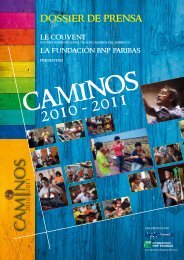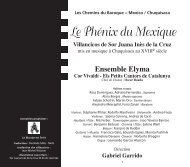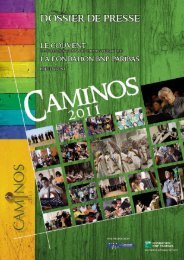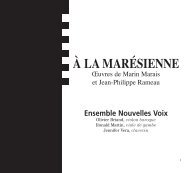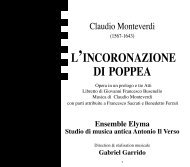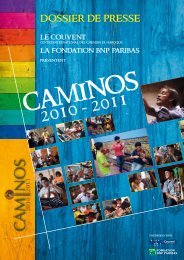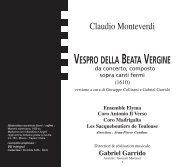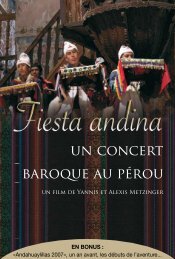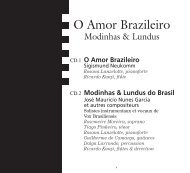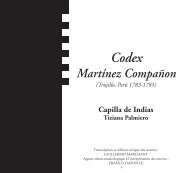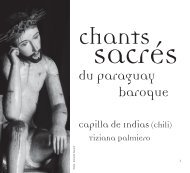Musique et poésie des Juifs en Italie à la Renaissance Music and ...
Musique et poésie des Juifs en Italie à la Renaissance Music and ...
Musique et poésie des Juifs en Italie à la Renaissance Music and ...
- No tags were found...
Create successful ePaper yourself
Turn your PDF publications into a flip-book with our unique Google optimized e-Paper software.
plus nombreux <strong>et</strong> plus diffusés du point de vuegéographique, tels les Ashkénazes ou les Séfara<strong>des</strong>.Cecil Roth a écrit, dans The History of the Jews in Italy,que “l’importance de l’hébraïsme itali<strong>en</strong>, à travers sesdeux millénaires d’histoire, est fondée plutôt sur <strong>la</strong>qualité que sur <strong>la</strong> quantité”.C<strong>et</strong> <strong>en</strong>registrem<strong>en</strong>t est consacré à l’héritage poétique<strong>et</strong> musical <strong>des</strong> communautés juives itali<strong>en</strong>nes, à uneculture aux horizons ouverts <strong>et</strong> à son répertoire vivant<strong>et</strong> multiforme. Ces chants <strong>et</strong> ces musiques sont lerésultat d’un croisem<strong>en</strong>t fertile, fils de <strong>la</strong> confrontation<strong>et</strong> de l’échange <strong>en</strong>tre cultures. Ce sont les témoinsd’un <strong>des</strong> rares mom<strong>en</strong>ts de cohabitation pacifique <strong>et</strong>de respect réciproque <strong>en</strong>tre les <strong>Juifs</strong> <strong>et</strong> leurs voisins.À Mantoue, une troupe théâtrale juive divertissait <strong>la</strong>cour <strong>des</strong> Gonzague <strong>et</strong> partout <strong>en</strong> <strong>Italie</strong>, les chréti<strong>en</strong>sr<strong>en</strong>dai<strong>en</strong>t visite aux quartiers juifs pour participer, aumoins <strong>en</strong> tant qu’observateurs curieux, aux festivitésde Pourim. Parmi les savants itali<strong>en</strong>s les plus éc<strong>la</strong>irés, ilexistait un réel intérêt pour <strong>la</strong> culture <strong>et</strong> <strong>la</strong> <strong>la</strong>ngue juive,alors que les intellectuels juifs, ainsi que les musici<strong>en</strong>s <strong>et</strong>les compositeurs, les acteurs <strong>et</strong> les m<strong>et</strong>teurs <strong>en</strong> scène,les fabricants de costumes de théâtre <strong>et</strong> les maîtres dedanse, les poètes <strong>et</strong> les dramaturges, les medicins, lesphilologues <strong>et</strong> les savants abondai<strong>en</strong>t dans <strong>la</strong> Péninsule.L’<strong>Italie</strong> du Nord fut une terre de r<strong>en</strong>contres <strong>et</strong> decroisem<strong>en</strong>ts pour les <strong>Juifs</strong> prov<strong>en</strong>ant de plusieurs lieuxdiffér<strong>en</strong>ts. Il y avait les Ashkénazes qui v<strong>en</strong>ai<strong>en</strong>t <strong>des</strong> paysgermaniques <strong>et</strong> qui par<strong>la</strong>i<strong>en</strong>t le yiddish ; les Séfara<strong>des</strong>d’Espagne, du Portugal <strong>et</strong> de <strong>la</strong> Méditerranée ori<strong>en</strong>tale ;<strong>et</strong> les Italikim, qui par<strong>la</strong>i<strong>en</strong>t itali<strong>en</strong> <strong>et</strong> affirmait leurprés<strong>en</strong>ce <strong>en</strong> <strong>Italie</strong> à l’époque de l’Empire romain. Lestemps étai<strong>en</strong>t difficiles. Il y eut les expulsions <strong>des</strong> terressous domination espagnole, y compris Naples <strong>et</strong> <strong>la</strong>Sicile, alors qu’<strong>en</strong> Allemagne les viol<strong>en</strong>ces se suivai<strong>en</strong>tsans répit. Tout naturellem<strong>en</strong>t, les villes du Nord <strong>et</strong> duC<strong>en</strong>tre de l’<strong>Italie</strong>, avec leur climat de tolérance re<strong>la</strong>tive,devinr<strong>en</strong>t une sorte d’aimant pour l’immigrationjuive. L’intégration <strong>en</strong>tre ces communautés séparéespar l’histoire, <strong>la</strong> <strong>la</strong>ngue <strong>et</strong> <strong>la</strong> culture ne se réalisapas sans friction <strong>et</strong> se superposa au système déjàtrès complexe <strong>des</strong> re<strong>la</strong>tions avec <strong>la</strong> société qui les8wi<strong>des</strong>pread Ashk<strong>en</strong>azic <strong>and</strong> Sephardic popu<strong>la</strong>tions.As Cecil Roth said in The History of the Jews in Italy,‘The importance of Italian Jewry, throughout its twomill<strong>en</strong>nia of history, has be<strong>en</strong> qualitative rather thanquantitative.’This program is dedicated to the musical <strong>and</strong> po<strong>et</strong>iclegacy of the Jewish communities of Italy, which pres<strong>en</strong>ta vast <strong>and</strong> <strong>en</strong>tertaining repertoire, the exuberantresult of the fertile crossover, fed by the confrontationb<strong>et</strong>we<strong>en</strong> differ<strong>en</strong>t cultures, made possible by oneof the rare mom<strong>en</strong>ts of peaceful cohabitation <strong>and</strong>mutual respect b<strong>et</strong>we<strong>en</strong> Jews <strong>and</strong> their neighbors.In Mantua, a Jewish theatrical group <strong>en</strong>tertained atthe Gonzaga court, <strong>and</strong> throughout Italy, the G<strong>en</strong>tilepopu<strong>la</strong>tion would visit the Jewish quarter to observ<strong>et</strong>he Purim festivities. Among <strong>en</strong>light<strong>en</strong>ed clerics, therewas a real curiosity about Jewish learning <strong>and</strong> practice,while Jewish musicians, composers, theatrical troupes,directors, costume-makers, dancing-masters, po<strong>et</strong>s <strong>and</strong>p<strong>la</strong>ywrights, as well as doctors, linguists, <strong>and</strong> sci<strong>en</strong>tists,abounded throughout the p<strong>en</strong>insu<strong>la</strong>.Northern Italy was the confrontation point b<strong>et</strong>we<strong>en</strong>a vari<strong>et</strong>y of Jewish communities: the Yiddish-speakingAshk<strong>en</strong>azim from north of the Alps; the Sephardim,from Spain <strong>and</strong> its holdings, Portugal <strong>and</strong> the Levant;<strong>and</strong> the Italikim, who spoke Italian <strong>and</strong> traced theirpres<strong>en</strong>ce in Italy back to the Roman Empire. Thiswas a period of turbul<strong>en</strong>ce throughout Europe,with expulsions from Spain, Portugal, the Kingdomof Naples <strong>and</strong> Sicily, <strong>and</strong> a series of repressionsthroughout Germany. It was only natural that northern<strong>and</strong> c<strong>en</strong>tral Italy, where the Jews found re<strong>la</strong>tive peace<strong>and</strong> prosperity, should become a magn<strong>et</strong> for Jewishimmigration. The interaction, not always withoutproblems, b<strong>et</strong>we<strong>en</strong> these distinct traditions, <strong>and</strong> thecomplex, y<strong>et</strong> close re<strong>la</strong>tionship that the Jews of Italyhad with the non-Jewish culture around them, were allcontributing factors to the formation of a rich cultural



